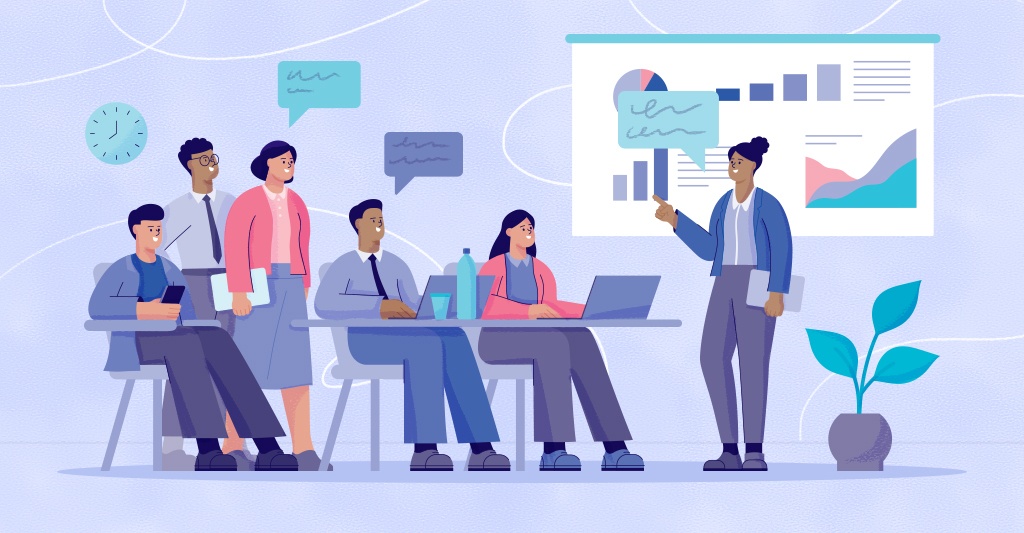Boost Your Onboarding With Personalized Employee Onboarding Maps
Companies dedicate significant time and resources to create formal onboarding programs that introduce new hires to the company and its culture, mission, and values. Many organizations also schedule strategic checkpoints throughout the year to get a pulse on how new employees are settling in and how they are feeling. [1] If you’re doing these things in your organization, good for you—these are great best practices!
But when it comes to showing new hires how to be successful in their specific role (what’s known as “functional onboarding”), things tend to get a bit more informal.
Why is this?
New employee onboarding is typically an enterprise-wide initiative owned and driven by HR or L&D teams, whereas the responsibility of creating functional onboarding often falls to hiring managers—in other words, busy people who are under-resourced.
Maybe you’ve experienced this yourself: you joined a new company and attended a formal orientation program only to discover that your functional onboarding consists of little more than shadowing an experienced colleague.
Or perhaps you’ve experienced this from the other side: you’ve been the hiring manager, and it’s been your responsibility to create an onboarding plan for a new hire on your team. With no time to create something comprehensive, you partner the new hire with an experienced team member for a job-shadowing experience.
With the stakes for creating positive new hire experiences higher than ever—33% of workers quit their job within the first 90 days they are employed [2]—adopting an informal approach to functional onboarding poses a significant risk.
What Are The Challenges With Functional Onboarding?
As I’ve already stated, most functional onboarding programs fall under the hiring manager’s responsibilities. In addition to not being experts in L&D, hiring managers are also busy people!
The experienced team members who are coaching new hires are also busy and in demand. What’s more, coaches usually have their own preferred way of working—meaning new hires will receive a different onboarding experience depending on which coach they’re partnered with.
Perhaps most importantly, no two new hires are alike; each will have different needs and expectations based on their own experience and expertise. Experienced hiring managers and coaches will be aware of their new hire’s needs and adapt their onboarding approach accordingly. Less experienced leaders and coaches might not be as agile in their approach.
When combined, this leads to an informal and inconsistent onboarding experience.
So, What’s The Solution?
Structured, personalized formal functional onboarding programs that meet the new hire’s needs and the needs of the managers and coaches. (With a little help from L&D!)
Imagine these scenarios…
Scenario 1: You joined a new company, attended a formal company onboarding program, and now it’s time to join your team. On Day One, you’re greeted by your hiring manager, who hands you a personalized learning journey with six months of functional onboarding activities mapped out just for you.
Scenario 2: You’re a hiring manager, and today you’re welcoming two new hires to the team: The first is a recent college graduate, while the second is an experienced internal hire. You meet, together with their appointed coaches, for a getting-to-know-you session and an orientation to the onboarding plan. When the meeting is over, you send the new hires off to start their activities. You’re confident that they’ll have enough formal and consistent activities to keep them busy until you check in with them again at the end of their first week—at which point you’ll know exactly what they’ve done and what they should know.
Sounds good, right?
Now I’ll show you how to achieve this with seven simple steps to improve the new employee functional onboarding experience.

7 Simple Steps For Transforming The Functional Onboarding Experience
Follow these steps to create a personalized functional onboarding experience that considers the differing needs of your new hires—as well as those of the coaches and hiring managers who’ll support them on their journey.
Step 1: Identify The New Hire Personas
The goal for this step is to look at the big picture and identify the overall types of new hires you’ll be welcoming and how their needs might differ. In our experience, new team members tend to fall into the following categories:
- New to the workforce. This group includes college graduates, interns, and any individuals with little to no previous work experience. These individuals typically need more in-depth training and support to better understand their role and responsibilities and how their work will impact their team and the company overall.
- New to the company. This category comprises individuals who’ve held similar roles at different companies. These folks should already have a clear understanding of the role, their responsibilities, and the types of tasks they’re likely to perform. They’ll need to understand how these duties look in your company.
- New to the department. Internal hires who are transferring from a different department and role will be included here. Since they’ll already be in tune with the company’s overall goal and mission—and may even have experience with some of the systems and tools they’ll need to use —these individuals will need to be onboarded to their role, responsibilities, and specific tasks.
Step 2: Map Out What Each New Hire Persona Should Know And Be Able To Do, And By When
The key to all successful employee onboarding experiences is to keep new hires engaged and make them feel supported, and ultimately, productive. Expect too much of them too soon, and they could lose confidence or feel that they aren’t progressing as quickly as they should. Hold experienced new hires back for too long, and they could end up feeling frustrated or worse—that they aren’t trusted to carry out the work.
Getting this balance between support and independence right doesn’t have to be a huge undertaking. Instead, you can keep things simple by identifying what each new hire persona should know and be able to do—their performance objectives—in the coming days, weeks, and months.
Begin this work by defining what fully proficient looks like. Leverage competency frameworks, if you have these in place! Next, identify when competency can be expected of each new hire persona. You can then work backward from there.
Generally speaking, and depending on the role, you should expect new hires who are new to the company to become proficient first, closely followed by those who are new to the department. New hires who are new to the workforce will probably take the longest to be fully proficient.
Step 3: Align The New Employee Onboarding Activities With Step 2
While this alignment might sound like another daunting task—particularly if you need to do it for several new hire personas—it really doesn’t have to be. In fact, if you get this bit right, you’ll only have to do the heavy lifting for one of the new hire personas.
How? Begin with the new hire persona that will need the most onboarding support: new to the workforce. Using the data gathered in Step 2, map out the formal and informal training, tasks, and activities that this new hire persona will need to become fully proficient in the role. This will become your master functional onboarding list that you’ll edit for the other new hire personas. For example:
- For new-to-company new hire personas: Begin with your master list, then remove any functional onboarding activities that overlap with the new hire’s existing experience (how to perform the job). Keep the company-specific and contextual activities (how we do things here).
- For new-to-role new hire personas: Here, you’ll do the opposite. Using your master list, you’ll keep the activities that show new hires how to perform the job. You can remove any company-specific or contextual activities that are redundant based on the new hire’s experience at the company.
Step 4: Map Out The Coaching Touchpoints
I threw some shade at shadowing at the beginning of this article, and I want to set the record straight: shadowing an experienced co-worker is one of the best ways to learn the ropes.
Where it can fall apart, however, is when it’s relied upon as the only type of functional onboarding activity. It can also go wrong when the coach being shadowed:
- Isn’t prepared for or aware of the training.
- Can’t be relied upon to be available whenever the new hire requires it.
To avoid these risks, I recommend building formal coaching touchpoints into the functional employee onboarding plan.
Working in partnership with the coaches, use the master functional onboarding list to identify which tasks require the supervision or support of a coach—and flag these accordingly.
See Steps 6 and 7 (below) for more information on formalizing and communicating these touchpoints with the coaches.
Step 5: Map Out The Hiring Manager Touchpoints
If the hiring manager is doubling as a coach and will be providing hands-on or one-on-one training and development, follow the instructions for Steps 4 and 5. If the hiring manager is not also a coach, set up the hiring manager touchpoints at strategic milestones throughout the functional onboarding experience. These are typically scheduled to coincide with the beginning or end of the new hire’s first day, first or second week, first month, third month, and sixth month.
Tip: Create touchpoints with purpose! Avoid making these touchpoints an arbitrary affair. In our experience, the most effective touchpoints combine a quick check-in to see how things are going along with a clear purpose or objective.
What might this look like? We recently worked with a client whose hiring manager touchpoints included a blend of:
- Guided discussions. These complete conversations included planned topics and conversation starters. For example, reviewing the department’s strategy and goals, coaching and mentoring programs, and what to expect during performance reviews.
- Action items and tasks. Again, these should be clearly listed. For example, setting up meet-and-greets with specific people or organizing access to functional systems and tools.
- Activities that can be completed together. Be sure to include clear instructions and provide links to any resources the new hire may need to prepare for or complete activities, such as completing a personal vision statement or identifying personal goals.
Reflect on and include the discussions, tasks, and activities that will offer the most value to new hires and hiring managers at each step along the functional onboarding experience.
Step 6: Put It All Together! Create Learning Journey Maps For New Hires, Coaches, And Hiring Managers
If you’ve been following the steps so far, you should have a clear understanding of:
- The different new hire personas and their specific needs
- How the onboarding training and activities will align with the needs
- When and where to bring the coaches for support
- When and how the hiring manager will interact with the new hires
All that’s left to do is document the functional onboarding journey—along with all relevant instructions and links to resources—with a learning journey map!
How you create your map is up to you! Our advice is to keep it simple. Use a system or tool that is easy to access in case of updates, such as an interactive PDF, your company’s intranet, or even a spreadsheet with tabs for each milestone in the functional onboarding journey (first week, first month, three months, six months, etc.). Ideally, it will be a tool that is visible to everyone involved in the onboarding process and has a checklist functionality so that tasks and activities can be marked complete.
Whichever method you choose, it’s vitally important that you create a version for each new hire persona as well as the coaches and hiring manager so that everyone has visibility into—and accountability for—their part in the experience.
Step 7: Onboard Everyone To The Plan
Finally, and most importantly, you’ll need to onboard everyone involved—new hires, coaches, and hiring managers—to the onboarding plan so that they understand what is expected of them and when.
Ask coaching and hiring managers to block their calendars to ensure they are ready and available when needed.

7 Steps To Employee Onboarding Success!
Follow these steps to create formal, personalized, and consistent functional onboarding experiences that keep your new hires engaged and productive for as long as it takes to become fully proficient in their roles—while easing the burden on hiring managers and coaches.
Need help with functional onboarding?
SweetRush is an award-winning custom learning provider that has been helping companies transform their new employee onboarding and functional onboarding programs since 2001. Get in touch to find out how we can help you with your onboarding challenge. It would make our day to hear from you!









